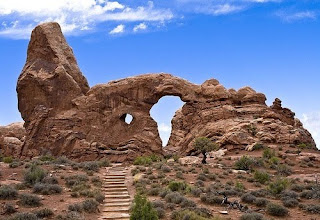Arches National Park is a U.S. national park in eastern Utah. It established as a National monument in 1929, and as a National Park in 1971. Arches National Park as know as contains one of the largest concentrations of natural sandstone arches in the world. It's land area is about 73,379 acres (297 square kilometer).
Before thousands of years, Archaic people, and later ancestral Puebloan, Fremont and Utes searched the arid desert for game animals, wild plant foods and stone for tools and weapons. They also left evidence of their passing on a few pictograph and petroglyph panels.

The ancestral Pueblo and the Fremont Indians left the area about 700 years ago. As the ancestral Puebloan and Fremont peoples, such as the Ute and Paiute, entered the area, they were here to meet the first Europeans in 1776. The petroglyph panel near Wolfe Ranch is believed to have some Ute images since it shows people on horseback, and horses were adopted by the Utes only after they were introduced by the Spanish.
Produce of Natural Arch:
Natural arch or natural bridge is a natural formation where a rock arch forms, with a natural passageway through underneath. Natural arches commonly form where cliffs are subject to erosion from the sea, rivers or weathering. The processes "find" weaknesses in rocks and work on them, making them bigger until they break through.
Arches National Park in over millions of years, the salt bed underneath was no match for the heavy layer of rock. Under the pressure of the rock, the salt layer shifted, buckled, and liquified, thrusting the layers upwards. Faults deep in the Earth caused movement that produced vertical cracks in the stone. Surface erosion stripped away the younger rock layers while, over time, water seeped into the long, straight cracks. Erosion along the straight cracks shaped the sandstone into slender, upright slabs of rock resembling walls. The slabs, when exposed on the surface are called "fins."

Once the faces of the fins are exposed, erosion begins to act here too. In the winter, water turns to ice putting pressure on the surrounding rock, breaking off bits and pieces. Wind and water attack the standing fins of rock and, in some, the cementing material gives way. Chuncks of rocks tumbled down. Many fins collapse, but some are strong enough to remain standing, becoming the famous arches.
Famous Aches and Sandstones in Arches National Park:
Landscape Arch

Landscape Arch to be the longest natural arch in the world, it is a staggering 290 feet long (almost a football field) and is as thin as 6 feet. In the past visitor could hike under the arch, but massive rock falls in 1991 and 1995 have forced the park service to close off access to the area.
Wall Arch
Its collapse in August 4, 2008. Before that, it was ranked 12th in size among the park's over 2,000 arches. It had 71 feet wide by 33 and half feet high.
Before collapse

After collapse

Delicate Arch

Delicate Arch is a 52 ft (16 m) tall freestanding natural arch. It is the most widely-recognized landmark in Arches National Park. Beside, its also the symbol for Arches National Park.
Balanced Rock

Balanced Rock is another one of the most popular features of Arches National Park. Balanced Rock is located next to the park's main road, at about 14.5 km from the park entrance. The total height of Balanced Rock is about 39 m, with the balanced rock rising 16.75 m above the base. Balanced rock named "Chip Off The Old Block", which fell during the winter of 1975/1976.
Skyline Arch

Sand Dune Arch

Cove Arch

Broken Arch

Double Arch

Double O Arch

Devils Garden

The Windows

Tower Arch

CourthouseTower

Park Avenue

Turret arch

Parade of Elephant

Tunnel Arch

Pine Tree Arch

Navajo Arch

Dark Angel sandstone
